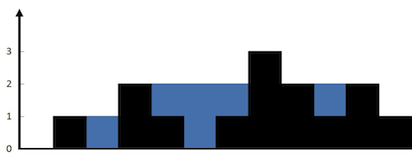LeetCode 솔루션 분류
[9/18] 42. Trapping Rain Water
본문
42. Trapping Rain Water
Hard
22787305Add to ListShareGiven n non-negative integers representing an elevation map where the width of each bar is 1, compute how much water it can trap after raining.
Example 1:

Input: height = [0,1,0,2,1,0,1,3,2,1,2,1] Output: 6 Explanation: The above elevation map (black section) is represented by array [0,1,0,2,1,0,1,3,2,1,2,1]. In this case, 6 units of rain water (blue section) are being trapped.
Example 2:
Input: height = [4,2,0,3,2,5] Output: 9
Constraints:
n == height.length1 <= n <= 2 * 1040 <= height[i] <= 105
Accepted
1,329,016
Submissions
2,271,134
관련자료
-
링크
댓글 1
학부유학생님의 댓글
- 익명
- 작성일
Runtime: 207 ms, faster than 54.49% of Python3 online submissions for Trapping Rain Water.
Memory Usage: 16 MB, less than 44.49% of Python3 online submissions for Trapping Rain Water.
Memory Usage: 16 MB, less than 44.49% of Python3 online submissions for Trapping Rain Water.
class Solution:
def trap(self, height: List[int]) -> int:
l, r = 0, len(height)-1
water = 0
lmax = rmax = 0
while l <= r:
lmax, rmax = max(height[l],lmax), max(height[r],rmax)
if lmax >= rmax:
water += rmax - height[r]
r -= 1
else:
water += lmax - height[l]
l+=1
return water









